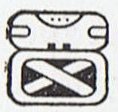|
6. The 4th - an unlucky number - station is Rohini with Aldebaran:
"The name Aldebaran is Arabic (al-dabarān) and translates literally as 'the follower', presumably because this bright star appears to follow the Pleiades, or 'Seven Sisters' star cluster in the night sky ... In Hindu astronomy it is identified as the lunar mansion Rohini and as one of the twenty-seven daughters of Daksha and the wife of the god Chandra ... Rohini, the red one', a name of Aldebaran. Also known as brāhmī." (Wikipedia) "The Hindu Rohinī, a Red Deer, used also for the nakshatra in Scorpio marked by Antares, was unquestionably from the star's ruddy bue ..." (Allen)
When counting on to Ga1-4, maybe significantly in position 477 (= 177 + 300), there is once again another number of days than 13:
... As a note to the colour red, we should remember that this word (or homonym) has two uses in several Mayance languages, and yet a third in the Maya of Yucatan. Chac means red, and is also an intenstive, 'very'. Chaccat in Kekchí translates the Zip glyph as 'red-?'. Chacavil is fever, and Chacekel tiger, in Maya; also intensive, chacetcun, to aggravate, increase. And similar forms in Quiché, Tzeltal, etc. And finally in Yucatan it is the common, still-known name of the Four Chacs, or Bacabs, rulers of the Quarters. Hatz'-chac may equally be read as fire-stick, heavy stroke, or 'bolt of the Chac' (Jupiter Tonans) ...
... The antlers were used when the Stag stole the fire and brought it to mankind, and this ought to have been when Spring Sun returned. Similar things should be born together. Close to the Stag there is a Rainbow ... (cfr at Schedir) "In May, the stag puts on his red summer coat." (The White Goddess) |
||||||||||||||||||||||||||||||||||||||||||||||||||||||||||||||||||||||||||||||||||||||||||||||||||||||||||||||||||||||||||||||||||||||||||||||||||||||||||||||||||||||||||||||||||||||||||||||||||||||||||||||||||||||||||||||||













